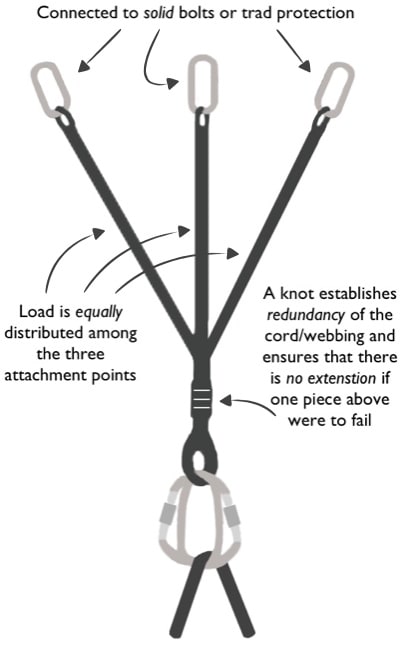Rock Climbing Anchors
As many of you are probably aware, there recently was a rock climbing related death in Joshua Tree National Park.
https://www.supertopo.com/climbers-forum/2384845/Recent-Climber-Death-in-JTree
Such incidents are quite sobering and completely tragic, and especially so if they could have been avoided. This particular death was attributed to a traditional gear anchor failure. This is unheard of in the climbing community, and should never ever happen.
Everyone has heard the phrase “climbing is inherently dangerous”. However, as we spend more and more time climbing on rock, we may become complacent to this danger. Such accidents are a shocking reminder that we do need to take heed to the warning message and approach climbing with the understanding that complacency can lead to severe injury, or even death!
There is an acronym used by most professionals when teaching anchor building: SERENE. This stands for Solid, Efficient, Redundant, Equalized, and No Extension. Below is a picture of a typical equalized anchor arrangement.
All traditional gear placements in an anchor should be Solid. There should be no question about the placement’s reliability or integrity. The rock quality that the gear is placed in should be carefully inspected for cracking, degradation/decomposing rock, and unstable formations. Gear placed well inside an unstable formation will not hold!
Gear usage should be Efficient. This means no extra pieces in the anchor, no questionable placements, and no “creative” placements when straight forward placements exist.
All anchors should be comprised of three pieces of gear. This is the Redundant factor. This is a safety measure that ensures in the case that one piece of gear in the anchor fails, there are still two more to back it up.
The gear should all be Equalized to equally share the load of the system. This is accomplished through the use of a cordilette, or other similar anchor system as demonstrated in the picture above. A knot near the “power point” of the anchor ties all three pieces of gear together. The power point is the loop where lockers are hung and the climbing/working rope passes through the anchor. In an ideal anchor, the angle between the outer most pieces is 90 degrees or less.
The anchor should be equalized in the direction of the climb. This ensures No Extension. In other words, if one piece fails, the anchor power point will not move. If an anchor is properly equalized in the direction of the pull, no extension will be inherent.
The Climbing Life Guides does offer classes on anchor building, gear placements, and lead climbing. If you feel you may need a refresher in these areas, contact us to book some time with a certified guide and rid yourself of any complacent habits!
Stay safe, and have fun out there!
Nelson
https://www.theclimbinglifeguides.com
May 1, 2014. Posted by: nelsonday
